
Primula is a genus of mainly herbaceous flowering plants in the family Primulaceae. They include the familiar wildflower of banks and verges, the primrose. Other common species are P. auricula (auricula), P. veris (cowslip) and P. elatior (oxlip). These species and many others are valued for their ornamental flowers. They have been extensively cultivated and hybridised - in the case of the primrose, for many hundreds of years. Primula are native to the temperate northern hemisphere, south into tropical mountains in Ethiopia, Indonesia and New Guinea, and in temperate southern South America. Almost half of the known species are from the Himalayas.

Phrymaceae, also known as the lopseed family, is a small family of flowering plants in the order Lamiales. It has a nearly cosmopolitan distribution, but is concentrated in two centers of diversity, one in Australia, the other in western North America. Members of this family occur in diverse habitats, including deserts, river banks and mountains.
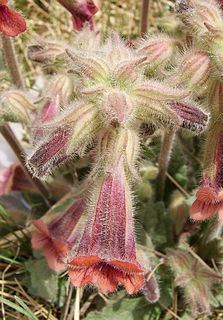
Rehmannia is a genus of six species of flowering plants in the order Lamiales and family Orobanchaceae, endemic to China. It is the only member of the monotypic tribe Rehmannieae. Contrary to the immense majority of the taxa of Orobanchaceae, Rehmannia is not parasitic.

Diplacus rupicola, the Death Valley monkeyflower, is a flowering plant in the family Phrymaceae.

Cardamine hirsuta, commonly called hairy bittercress, is an annual or biennial species of plant in the family Brassicaceae, and is edible as a salad green. It is common in moist areas around the world.

Atractylodes is a genus of Asian flowering plants in the sunflower family.

Banksia hirta is a species of shrub that is endemic to Western Australia. It has hairy stems, deeply serrated leaves, pale yellow flowers in heads of about one hundred and shining follicles. It is restricted to the Stirling Range National Park.
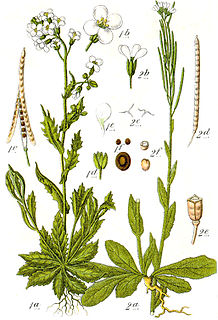
Arabis hirsuta, known as hairy rock-cress, is a flowering plant of the genus Arabis in the family Brassicaceae. In previous North American works, this species has been broadly defined to include plants native to Europe, Asia, and the northern half of North America, but is now more often restricted to a narrower subgroup restricted to Europe.

Hakea teretifolia, commonly known as the dagger hakea, is a species of woody shrub of the family Proteaceae and is common on heathlands in coastal eastern Australia from northern New South Wales through to Victoria and Tasmania. A very prickly shrub, it is rarely cultivated but easy to grow.
Diplacus aridus, is a species of monkeyflower with yellow blossoms. It was formerly known as Mimulus aridus.
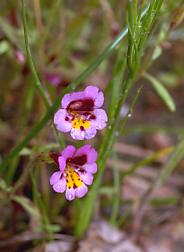
Erythranthe filicaulis, known by the common name slender-stemmed monkeyflower, is a species of monkeyflower. It was formerly known as Mimulus filicaulis.

Diplacus mephiticus is a species of monkeyflower known by the common names skunky monkeyflower and foul odor monkeyflower. It was formerly known as Mimulus mephiticus.
Erythranthe parishii is a species of monkeyflower known by the common name Parish's monkeyflower. It was formerly known as Mimulus parishii.

Diplacus pictus is a species of monkeyflower known by the common name calico monkeyflower.

Roscoea tibetica is a perennial herbaceous plant native to the mountains of China, being found in Tibet, Sichuan and Yunnan. The species formerly included plants found in Bhutan; in 2000, these were separated into a new species, Roscoea bhutanica. Most members of the ginger family (Zingiberaceae), to which it belongs, are tropical, but R. tibetica, like other species of Roscoea, grows in much colder mountainous regions. R. tibetica is sometimes grown as an ornamental plant in gardens. In 2020, it was proposed that R. tibetica be split again.
Wightia is a genus of flowering plants tentatively sister to the Phrymaceae which currently contains only two species. It grows as a tree, or a hemiepiphytic pseudo-vine, up to 15 metres (49 ft) tall. It is found in South Asia and South East Asia, from Nepal and India to Thailand, Vietnam and China's Yunnan Province, at altitudes below 2,500 m (8,200 ft). There are still morphological characters as well as nuclear genome data to support Wightia as sister to Paulownia leading it to be of proposed hybrid origin from Phrymaceae and Paulowniaceae. Due to chloroplast and mitochondrial data showing Wightia as sister to Phrymaceae it is proposed that a new family Wightiaceae be recognized.

Lancea tibetica is a herbaceous plant of the Mazaceae family. Lancea tibetica is found in grasslands, sparse forests, along streams between the altitudes of 2000 and 4500 meters in the Gansu, Qinghai, Sichuan and Tibet Autonomous Region regions of China, Bhutan, India, Mongolia, Sikkim and Nepal.
Melica tibetica, is a grass species in the family Poaceae that is endemic to China and can be found in such provinces as Inner Mongolia, Qinghai, Sichuan, and Tibetan Autonomous Region.
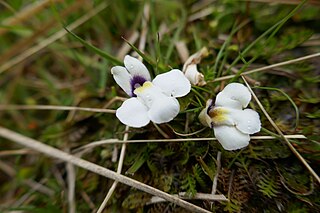
Mazaceae is a family of plants in the order Lamiales. The family was described by James L. Reveal in 2011. Genera in this family were most recently previously included in Phrymaceae and in older classifications were placed in Scrophulariaceae.
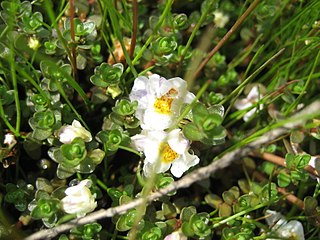
Thyridia repens, with common names creeping monkeyflower, Native musk, Maori musk, and native monkey flower, is a herbaceous succulent plant native to New Zealand and Australia that grows as low mats. Its flowers are light purple or white. It is the only species in the genus Thyridia.
















